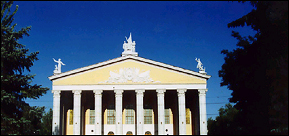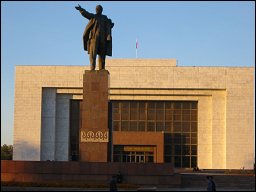 FACTS AND
FIGURES FACTS AND
FIGURES |

What Kyrgyzstan lacks in gracious buildings and
fancy architecture it more than makes up for with
nomadic traditions such as laid-back hospitality,
a healthy distrust of authority and a fondness for
drinking fermented mare's milk. Many travellers
find Kyrgyzstan the most appealing, accessible and
welcoming of the Central Asian republics, particularly
as it contains the central Tian Shan and Pamir Alay
ranges, Central Asia's finest mountains.

After the collapse of the Soviet Union in 1991,
the tiny Kyrgyz Republic clearly under-equipped
was left standing on a single a limb, seemingly
without the resources to survive on its own. So
far it's getting by on pluck, a liberal agenda and
goodwill from Western donor countries. It's more
progressive and doing more than any Central Asian
republic to encourage tourism and streamline bureaucratic
procedures
for visitors - partly because tourism is one of
the few things it has to sell to the outside world.
Away from Bishkek, Issyk-Kul and parts of the Tian
Shan, tourist infrastructure is either minimal or
wretched, transport is limited, fuel overpriced,
roads un-policed and there is a growing crime rate,
fuelled by alcohol and desperate poverty. You should
resist the temptation to just hop off the bus in
the middle of nowhere and hike into the hills. This
said, several rural home stays have popped up in
places like Naryn, Jalal-Abad, Suusamyr, Sokuluk
and Kemin, providing cheap accommodation and transportation
- they are early signs of a developing tourist awareness
in some parts of the countryside. The most important
thing is to check with your nearest embassy or consulate
and especially with other travellers before venturing. |

·FULL COUNTRY NAME: Kyrgyz Republic
·CAPITAL: Bishkek (formerly Frunze), 700.000
inhabitants.
·LOCATION: Bordering on Uzbekistan, Kazakhstan,
Tajikistan and China.
·PRESIDENT: Askar Akayev (re-elected to
a third, five-year term on Oct. 29, 2000)
·INDIPENDENCE: August 31, 1991 (from Soviet
Union)
·TIME: 4 hours ahead of UTC (GMT).
·SURFACE: 198.500 s·km (Switzerland
41.293 s·km); Mountains 94 %, plains 6
%, high mountains 70 %, other 23 %
·POPULATION 5 Mio
·TOWNS: Bishkek (700,000), Osh (215,000),
Tokmak (71,000), Karakol (formerly Przhevalsk
64,000).
·LANGUAGES Kyrgyz, Russian.
·NATIONALITIES Kyrgyz (60 %), Russians
(16 %), Uzbeks (14 %), Ukrainians (2 %), Dungans,
Kazakhs (1 %), Tajiks (1 %), Tatars (1 %), Germans
(0,5%), Uighurs, Koreans, Chinese.
·RELIGIONS: Sunni Muslim (75%), Russian
Orthodox (20%), other (5%)
·CURRENCY 1 Som = 100 Tyin.1 US-$ = ca.
48 Som (03/02). 1 Euro = 45 Som
INTRNATIONAL DIALING CODE: 996
·BEST TIME TO VISIT: Northern Kyrgyzstan
(Naryn) - June-September
Southern Kyrgyzstan (Osh) - March-October
·GDP growth rate: 4.6%
·Per capita GDP: $1500
·Imports of goods and services: $1.4 billion
·Major industries: Small machinery, textiles,
food processing, cement, shoes, sawn logs, refrigerators,
furniture, electric motors, gold, rare earth metals,
tobacco, cotton, potatoes, vegetables, grapes,
fruits and berries, sheep, goats, cattle, wool
·Major import trading partners: Russia
24.2%, Uzbekistan 14.5%, Kazakhstan 8.9%, Germany
6.2%, China 5.3%
|

